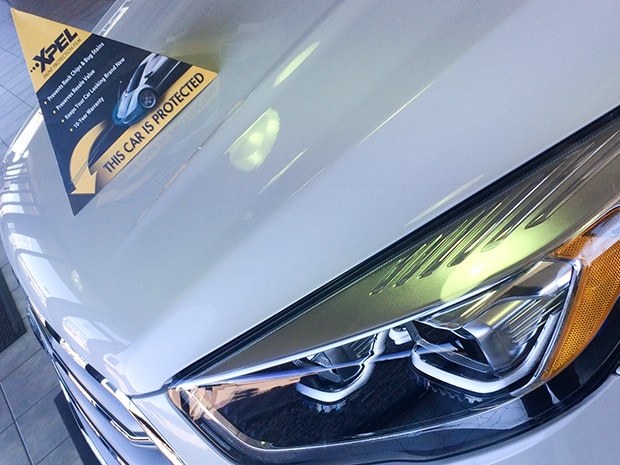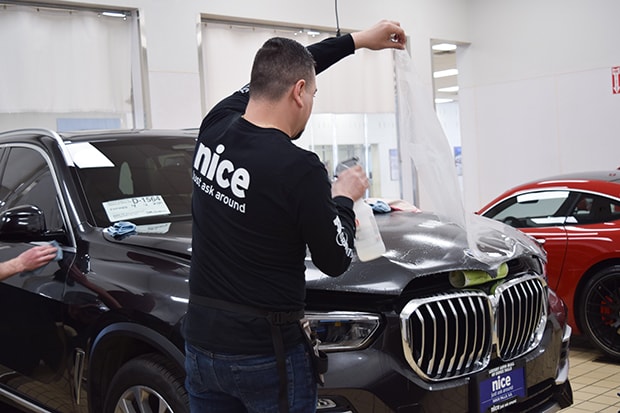
Also known as chip guard or clear bra. XPEL Paint Protection Film provides a barrier between your car and the open road. This film is applied to the painted surfaces of a car or even components like the headlights. You can go as far as wrapping your entire vehicle. It’s the best way to protect your car and keep it looking like new.
- Virtually invisible and protects from stone chips, oils, bug splatters, salt and minor abrasions
- Precision cut for a perfect fit every time
- Self-healing material and will NOT yellow, crack, fade or discolor
- Backed by an industry best warranty
We heard stories from many guests, so we know that this paint protection film is for every kind of driver. It works great for those who travel a lot, especially during the summer nights when bugs are out. Bugs splatter, but most people don’t realize that they are acidic and can eat away at the paint – leaving permanent “bug splatters”.
Then there are those who may drive too close to the vehicle in front of them. There is always some level of rocks or debris that tires can throw back. Drivers may never notice unless it is a big rock, but these small chips on the front become visible when you wash the bumper.
What does self-healing mean
The self-healing clear coat of XPEL is designed to repair itself from swirl marks, scratches from car washes, etc. It heals with heat from the sun, or even applying some water to it. If a piece of debris has penetrated all the way through the clear coat on the film, it will not self-heal.
Why XPEL installed at Luxury Auto Mall of Sioux Falls
We are the installation experts with a combined 30+ years of experience. Our PPF kits are cut with precision using our Graphtec plotter and XPEL software offering a perfect fit every time. When you are dealing closely with the paint finish of your vehicle, details matter, and that is why we are here.

Common questions about XPEL Paint Protection
Can The Film Be Waxed?
While you can wax the film, be sure the product you are using doesn’t contain Naphtha or Kerosene in concentrations over 5%, and avoid waxes that contain dyes.
How Deep Of A Scratch Can Film Still Heal?
The clear coat is the self-healing layer and is approximately 13 microns thick. If that layer is penetrated, the film will not heal.
Can I Run My Car Through An Automatic Car Wash?
Yes, but please wait at least 48 hours after installation to allow the film to dry completely
What Happens If You Put Acry-Solvent On The Film?
Acry-solvent, or any other Xylene based solvent, will not harm the film unless left sitting saturated in it for an extended period. To use this type of solvent on the film (for removing stains, etc.) wet a microfiber towel with the product and wipe the film for one or two minutes. If the stain remains, allow the solvent to evaporate and then repeat the process.
Can I Use A Pressure Washer, And How Soon After Install?
Yes, pressure washers can be used on XPEL paint protection films, provided the film has completely dried after installation (typically 48 hours) and provided the high-pressure water is not pointed directly at the edges of the film.
Can XPEL Be Installed On Your Vehicles Headlights And Fog Lights?
Yes, XPEL can be installed on your cars headlamps and fog lamps
If I Get A Partial Front End Wrap, Will The Edge Of The Film Be Noticeable?
While the edge of the film can be seen from certain angles, people generally do not notice it unless they are looking for it. However, if the car is dirty and dust and dirt can collect along the edge of the film, it will be more noticeable. Once the car is cleaned, it will be once again difficult to detect unless looking for it.
Can XPEL Be Applied Over A Vehicle That Has Had Paint Touch Ups?
Yes. Though you can install the film over any quality of touch-up, the best possible appearance will be obtained if the touched up area has been color-sanded smooth and buffed after the application of the paint.
Will Removing The Film Harm The Vehicles Paint, Once Removed?
It is highly unlikely for paint protection film to harm OEM paint. That being said, it is still recommended to have a professional remove the film in accordance with our published guidelines.
